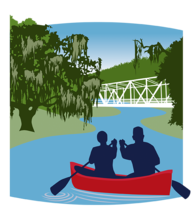The Bayou Teche National Byway has long been recognized as a travel corridor to and through important cultural, historic, natural, recreation and scenic environments. It is located in a three-parish area of Louisiana that exists along the beautiful Bayou Teche west of the Atchafalaya Basin from Morgan City through Franklin, New Iberia, St. Martinville, Breaux Bridge and on to Arnaudville. Primary access to the Bayou Teche Byways occurs from Interstate 10 and US 90.
Bayou Teche is the most famous and the most handsomely endowed bayou in the state, curling for miles through south central Louisiana, west of the Atchafalaya Swamp. The Bayou Teche Byway hugs the slow-moving bayou that runs through the three parishes of St. Martin, Iberia, and St. Mary. Notable towns located along the Bayou Teche Byway include Breaux Bridge (the crawfish capital), St. Martinville (of Evangeline fame), New Iberia (home to rice, sugar cane and TABASCO), Charenton (the site of the Chitimacha Indian reservation, noted for its exquisite double-walled cane baskets), Patterson (Louisiana Aviation and Cypress Sawmill Museum) and Morgan City (home to the first submersible oil drilling rig, the Mr. Charlie).
The Bayou Teche National Byway is so culturally rich that it is an integral part of the Atchafalaya National Heritage Area, designated by Congress as a place where natural, cultural, and historic resources combine to form a cohesive, nationally important landscape. Through its resources, the Bayou Teche Byway tells nationally important stories that celebrate our nation’s diverse heritage. To be a national heritage area, first, the landscape must possess nationally unique natural, cultural, historic, or scenic resources. Second, when the sites are linked, they must tell a unique story about the United States. The Atchafalaya National Heritage Area is not a National Park Service unit or federally owned or managed land. It is a lived-in landscape Stories of the Bayou Teche National Byway include Native American, Acadian and Spanish descendants who inhabited this area and survived off the land. The Chitimacha Indians named the area teche, which is a Chitimacha word meaning snake. The Chitimacha are internationally known for their beautiful and complicatedly woven cane baskets. Some settlers became cattle ranchers or engaged in small-scale farming and fishing along the bayou’s banks. Anglo settlers coming into the region after the Louisiana Purchase established successful sugar cane plantations, lining the bayou with mansions of architectural note. The Shadows-on-the-Teche in New Iberia, a property of the National Trust for Historic Preservation, is an example of a wealthy sugar cane planter who built his family mansion on the bayou. Others became loggers and harvested the plentiful Cypress trees in the Atchafalaya Basin. These trees were used to build towns, houses and businesses. The Cypress Sawmill Museum (part of the Louisiana State Museum properties) tells the story of the settlers lust for Cypress and its many functions in the place called Teche.
As time passed, occupations and trade of the settlers changed. Oil and gas were introduced and offshore oil rigs became places of work. The International Petroleum Museum and Exposition: The Mr. Charlie, is the only place where visitors can tour an oil rig and visualize themselves living and working with several dozen other men in a relatively small space on an oil rig located in the Gulf of Mexico. Exhibits and artifacts tell the dangerous, but exciting story. Innovators and inventers settled along Bayou Teche to make use of the vast natural resources or to develop industries. TABASCO, growing its own peppers and using the salt found in huge salt domes on Avery Island, created its distinctive brine for the world-famous hot sauce that is a popular ingredient in Cajun food. Wedell-Williams, two pioneering aviators, built their racing planes in the quaint community of Patterson, where a museum now memorializes their achievements.
The Bayou Teche National Byway tells stories of the values, tenets, and beliefs that guide daily lives and social interactions of the people who reside along the bayou. These values are the product of both a vibrant, underlying culture and the lived experiences of the inhabitants. Conditions and circumstances in and around the Basin made harsh demands on inhabitants, while also offering them unique opportunities. The people and their way of life is Teche.
If the overarching story of the Bayou Teche Byway is wide-ranging and broad, it is also concrete and specific. Indigenous manifestations of the Bayou Teche’s culture include music, foodways, religion, occupations, inventiveness and other such expressions of culture. These constitute the distinctive experiences that visitors encounter while touring the Bayou Teche National Byway.
FIND MORE INFORMATION:
Iberia Parish Convention and Visitors Bureau
Cajun Coast Convention and Visitors Bureau
St. Martin Parish Tourist Commission






